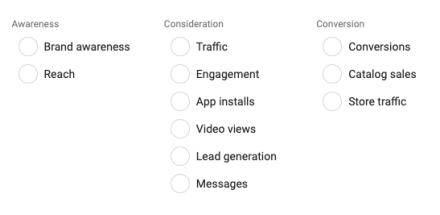When building a new Facebook campaign, which type should you choose: Awareness, Consideration, or Conversion?
These categories represent different stages in the lead/customer cycle and can have a great impact on the outcome of your campaign.
Each category has multiple objectives to choose from, so let’s dive deeper into those!
Campaign Objective Options in Facebook Ads Manager

For people unfamiliar with their options, this can be a confusing choice to make. If you are not 100% sure about the differences between objectives, how can you possibly make an informed decision on which one to select?
One mistake that we see time and time again involves people/businesses trying to sell a product or service. They end up selecting the Traffic campaign because they want to get more people to visit their website and buy something.
On the surface, this makes sense. We want to run ads to generate traffic so that more people will visit our website and make a purchase.
So, if making a sale is our ultimate goal, the website will significantly benefit from increased traffic because this campaign will put more potential buyers on our web pages. Right?
Unfortunately, that’s not how it works. When you choose the Traffic objective, this indicates to Facebook that you want to get as many people to visit your website as possible.
This is an issue because this type of campaign isn’t based on whether these visitors convert or not. Instead, Facebook simply serves ads to the people who are most likely to click on them and visit your page.
While traffic is important, what we are really looking for in this case is conversions. Our desire as vendors of goods or services is to bring actual customers or potential leads to our sites. The goal of our campaign is to make conversions, whether that is in the form of leads, purchases, downloads, or whatever else.
If you select the Conversion objective instead of the Traffic objective, Facebook will optimize your ads to focus on people who are most likely to visit and convert (make a purchase) on your site rather than simply viewing.
This may seem like a relatively small distinction, but the results are dramatically different and could cost or save you a lot of money!
Difference In Performance Between Conversion and Traffic Objectives
Selecting the proper objective for your campaign is extremely important and cannot be emphasized enough. Each type of objective has its purpose, and understanding how to differentiate between them is vital.
Below, we show our results when experimenting with the ‘Conversion’ and ‘Traffic’ campaign objectives. Please note that both campaigns ran ads to the same audience but, as you will notice, have very different results.
Traffic Objective Campaign
We ran our first campaign using the ‘Traffic’ objective. The total cost for our campaign was just over $1,200. However, as you can see below, this particular campaign only generated three leads.
This means that our cost per lead (or potential sale) for running a traffic campaign was a whopping $400!

Conversion Objective Campaign
Our cost per lead dropped significantly when we switched our campaign to the ‘Conversion’ campaign objective.
In this campaign, we generated 499 leads, which gave us a cost per lead of $54.
As you see, using the ‘Conversion’ objective proved to be significantly more effective than the ‘Traffic’ objective!

Optimize Your Facebook Campaign
There is a time and place for each campaign objective depending on your marketing goals and specific business.
The traffic objective is better used when looking to increase awareness via blog viewership for example.
Or if you are looking to build your pixel audience for a future retargeting campaign, the traffic objective might yield you cheaper clicks (aka website visits).
However, if you’re trying to generate leads or make sales and are still using the Traffic objective, we definitely recommend giving that decision a second thought!
Need more guidance? Reach out to us!
Related Posts
- The Ultimate Guide on Creating a Facebook Ads Strategy in 2023
- Facebook Ads Best Practices In 2023
- How To Create an Effective Landing Page for Facebook Ads
- How To Optimize Facebook Ads for The Highest ROI
- Facebook Ads for Small Businesses: The Most Bang For Your Buck
- Facebook Ads vs Boosted Posts: Which Is Better For You?
- The Facebook-Ad Checklist to Review Before Launching Any Campaign
- Are Facebook Ads Worth it? Pros and Cons of Facebook Ads
- What is a Good ROAS for Facebook Ads?
- How to Write FaceBook Ad Copy That Sells
- Facebook Business Manager Overview
- Increase ROAS with Facebook Lookalike Audiences
- Why You Should Use Campaign Budget Optimization
- Build Lookalike Audiences Using Lead Ads
- Connecting Your Lead Form to Your CRM
- How to Find Lead Forms in Facebook
- Facebook Retargeting Strategy
- Overview of Facebook Objectives & Ad Formats
- Facebook Ad Frequency 101
- How to Organize Your Facebook Ads Campaign
- Facebook’s Estimated Ad Recall Lift: Everything You Need to Know
Previous Blog
Previous BlogHow Does Pay Per Click Work?



